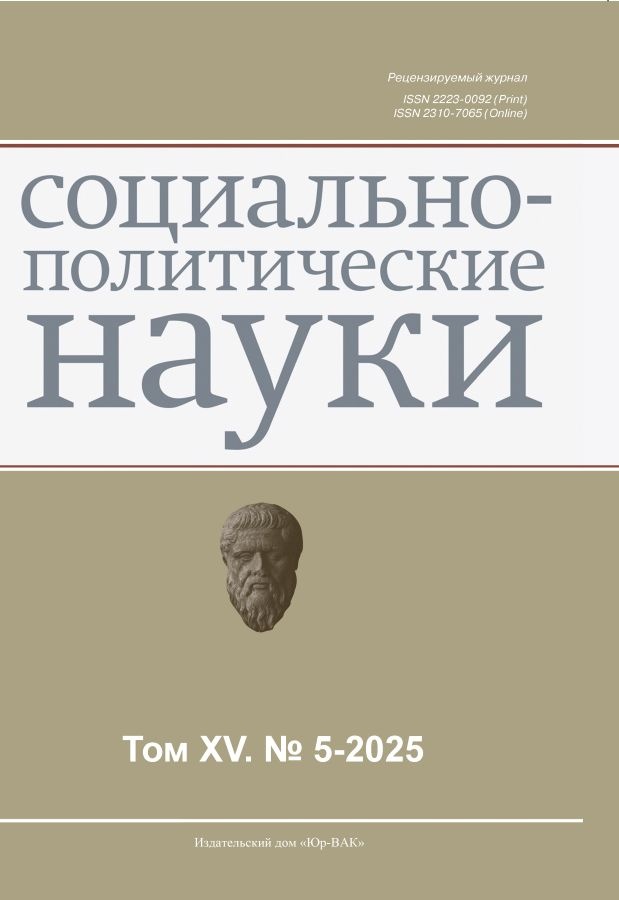Definition of the Essence of the Meta-scientific Concept of “Compliance” by Methods of Synchrony and Diachrony
- 作者: Kuznecova L.Е.1
-
隶属关系:
- Vladimdir State University named after Alexander and Nikolay Stoletovs
- 期: 卷 15, 编号 5 (2025)
- 页面: 257-268
- 栏目: Social and Political Philosophy
- URL: https://journals.eco-vector.com/2223-0092/article/view/696815
- DOI: https://doi.org/10.33693/2223-0092-2025-15-5-257-268
- EDN: https://elibrary.ru/DQAKNV
- ID: 696815
如何引用文章
详细
In order to identify a number of socio-philosophical aspects and foundations, this article examines the modern metascientific concept of “compliance” using linguistic methods developed by Ferdinand de Saussure. The first part presents the key principles of the theory of the linguistic sign and describes two main methods of studying it: synchrony and diachrony. The second part substantiates the extrapolation of linguistic methodology to philosophical research. In the third part, the term “compliance” is examined as a linguistic sign in its diachronic aspect: from the emergence of its root in Proto-Indo-European to subsequent stages of historical transformation of the content of the “signified” in Latin, Vulgar Latin, Old French, and English. The original use of the concept in English is identified in social and religious contexts as voluntary or forced submission to authorities, political circumstances, social norms, diplomatic agreements, canons of faith, etc. Synchronic data is then provided on the current connotations of the term “compliance” in medicine, economics, engineering, law, computer science, and other sciences. A contemporary trend in the application of this concept in religious studies is identified, described as a return to its origins. This example confirms F. de Saussure’s principle of the arbitrariness of the relationship between signifier and signified in a linguistic sign, which invariably rests on historical tradition.
全文:
作者简介
Lilia Kuznecova
Vladimdir State University named after Alexander and Nikolay Stoletovs
编辑信件的主要联系方式.
Email: lika.smidt@mail.ru
SPIN 代码: 5827-9486
research associate, Department of Philosophy and Religious Studies
俄罗斯联邦, Vladimdir参考
- Dvoretsky I.Kh. Latin-Russian Dictionary. Moscow, 1976. 1096 p.
- Ermakova N.A., Akhunyanova Ch.F. Compliance control in the internal control system of corporations. International Accounting. 2014. No. 3 (297). (In Rus.)
- Lazarev Ya.O. IP compliance for business. Property Relations in the Russian Federation. 2021. No. 4 (235). Pp. 78–83. (In Rus.)
- Markova N.M., Arinin E.I., Kuznetsova L.E. Compliance, religionyms and confessional names before religions and confessions: Challenges to academic religious studies. Peoples and Religions of Eurasia. 2025. Vol. 30. No. 1. Pp. 170–192. (In Rus.)
- Mikirtichan G.L., Kaurova T.V., Ochkur O.K. Compliance as a medical, social and ethical problem in pediatrics. VSP. 2012. No. 6. Pp. 5–10. (In Rus.)
- Foucault M. Words and things: Archaeology of the humanities. St. Petersburg, 1994. 407 p.
- Bulanyi B. Regularity for optimal compliance problems with length penalization. Optimization and control (math. OC). Université Paris Cité, 2021. 185 p.
- Leamaster R., Bautista A. Understanding compliance in patriarchal religions: Mormon women and the latter day saints church as a case study. Religions. 2018. No. 9 (5). P. 143. doi: 10.3390/rel9050143.
- Nunung Nurul Hidayah. Religious compliance in Islamic financial institutions. Aston University, 2014. 191 p.
- Saussure F. de. Course in general linguistics. Paris, 1931. 285 p.
补充文件








